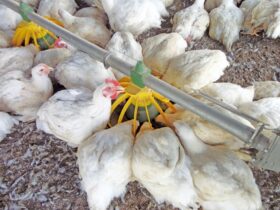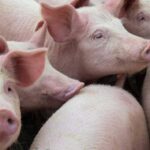Reporting Period: November 6-12, 2025
Extracted Data by Disease Category
1. ASF in Domestic Pigs
| Country | Number of Outbreaks | |
|---|---|---|
| Romania | 15 | |
| Moldova | 1 | |
| TOTAL | 16 |
2. ASF in Wild Boar
| Country | Number of Outbreaks | |
|---|---|---|
| Bulgaria | 32 | |
| Germany | 25 | |
| Estonia | 8 | |
| Croatia | 14 | |
| Hungary | 8 | |
| Italy | 7 | |
| Latvia | 21 | |
| Lithuania | 4 | |
| Poland | 4 | |
| Romania | 12 | |
| North Macedonia | 1 | |
| TOTAL | 136 |
3. HPAI (NON-P) in Captive Birds / H5N1
| Country | Number of Outbreaks | |
|---|---|---|
| Bulgaria | 1 | |
| Czech Republic | 2 | |
| Germany | 4 | |
| France | 3 | |
| Netherlands | 1 | |
| TOTAL | 11 |
4. HPAI (NON-P) in Wild Birds / H5 (N untyped)
| Country | Number of Outbreaks | |
|---|---|---|
| Norway | 1 | |
| TOTAL | 1 |
5. HPAI (NON-P) in Wild Birds / H5N1
| Country | Number of Outbreaks | |
|---|---|---|
| Austria | 8 | |
| Belgium | 4 | |
| Germany | 462 | |
| Denmark | 15 | |
| Spain | 16 | |
| Finland | 3 | |
| France | 25 | |
| Ireland | 1 | |
| Italy | 1 | |
| Lithuania | 1 | |
| Luxembourg | 8 | |
| Latvia | 3 | |
| Netherlands | 22 | |
| Poland | 2 | |
| Slovakia | 1 | |
| Slovenia | 2 | |
| Sweden | 5 | |
| Switzerland | 1 | |
| Norway | 1 | |
| Ukraine | 1 | |
| TOTAL | 581 |
6. High Pathogenicity Avian Influenza Viruses (Poultry) (Inf. with) / H5N1
| Country | Number of Outbreaks | |
|---|---|---|
| Bulgaria | 1 | |
| Czech Republic | 3 | |
| Germany | 26 | |
| France | 7 | |
| Hungary | 1 | |
| Ireland | 1 | |
| Italy | 2 | |
| Netherlands | 3 | |
| Poland | 3 | |
| Sweden | 2 | |
| United Kingdom (Northern Ireland) | 2 | |
| TOTAL | 51 |
Summary Statistics
| Disease Category | Total Outbreaks |
|---|---|
| ASF in Domestic Pigs | 16 |
| ASF in Wild Boar | 136 |
| HPAI(NON-P) in Captive Birds / H5N1 | 11 |
| HPAI(NON-P) in Wild Birds / H5 (N untyped) | 1 |
| HPAI(NON-P) in Wild Birds / H5N1 | 581 |
| High Pathogenicity Avian Influenza Viruses (Poultry) / H5N1 | 51 |
HPAI (NON-P) – High Pathogenicity Avian Influenza in Non-Poultry
This designation refers to HPAI infections occurring in birds that are NOT commercial poultry:
Captive Birds:
- Birds kept in zoos, aviaries, wildlife centers, or as pets
- Examples from report: Indian Peafowl, Muscovy Duck
- These are non-commercial birds under human care
Wild Birds:
- Free-living birds in natural habitats
- Examples from report: Mallard, Mute Swan, Common Crane, Grey Heron, Greylag Goose, Herring Gull, Eurasian buzzard, Whooper Swan, Common pheasant
Subtype Nomenclature
H5N1:
- H5 = Hemagglutinin protein type 5
- N1 = Neuraminidase protein type 1
- Full virus identification with both surface proteins characterized
- The most prevalent highly pathogenic strain globally
H5 (N untyped):
- Only hemagglutinin type identified (H5)
- Neuraminidase type not yet determined through laboratory testing
- Preliminary identification pending complete characterization
HPAI in Poultry (Inf. with):
Refers to infections in commercial poultry operations:
- Chickens, turkeys, ducks, geese raised for meat or eggs
- High impact on food security and international trade
- Triggers specific control measures including culling
Why These Classifications Matter:
- Epidemiological Tracking: Wild birds serve as natural reservoirs and spread virus through migration routes
- Risk Assessment: Different species require different control strategies
- Trade Implications: HPAI in commercial poultry directly affects international trade regulations
- Public Health Monitoring: Tracking which strains affect which species helps assess zoonotic (animal-to-human) transmission risk
- Control Measures:
- Commercial poultry can be culled and vaccinated
- Wild birds require surveillance and monitoring
- Captive birds need biosecurity measures
Geographic Distribution Highlights
ASF:
- Wild boar outbreaks (136) vastly outnumber domestic pig outbreaks (16)
- Germany had the most wild boar cases (25), Romania had most domestic pig cases (15)
- Concentrated in Eastern and Central Europe
HPAI:
- Germany dominated with 462 wild bird outbreaks and 26 poultry outbreaks
- Wild bird outbreaks (581) significantly exceeded poultry outbreaks (51)
- Widespread across Europe, indicating active transmission
Data Source: ADIS (Animal Disease Information System) Weekly Notification Created: November 14, 2025
This media comes from the Centers for Disease Control and Prevention’s Public Health Image Library (PHIL), with identification number #1841














